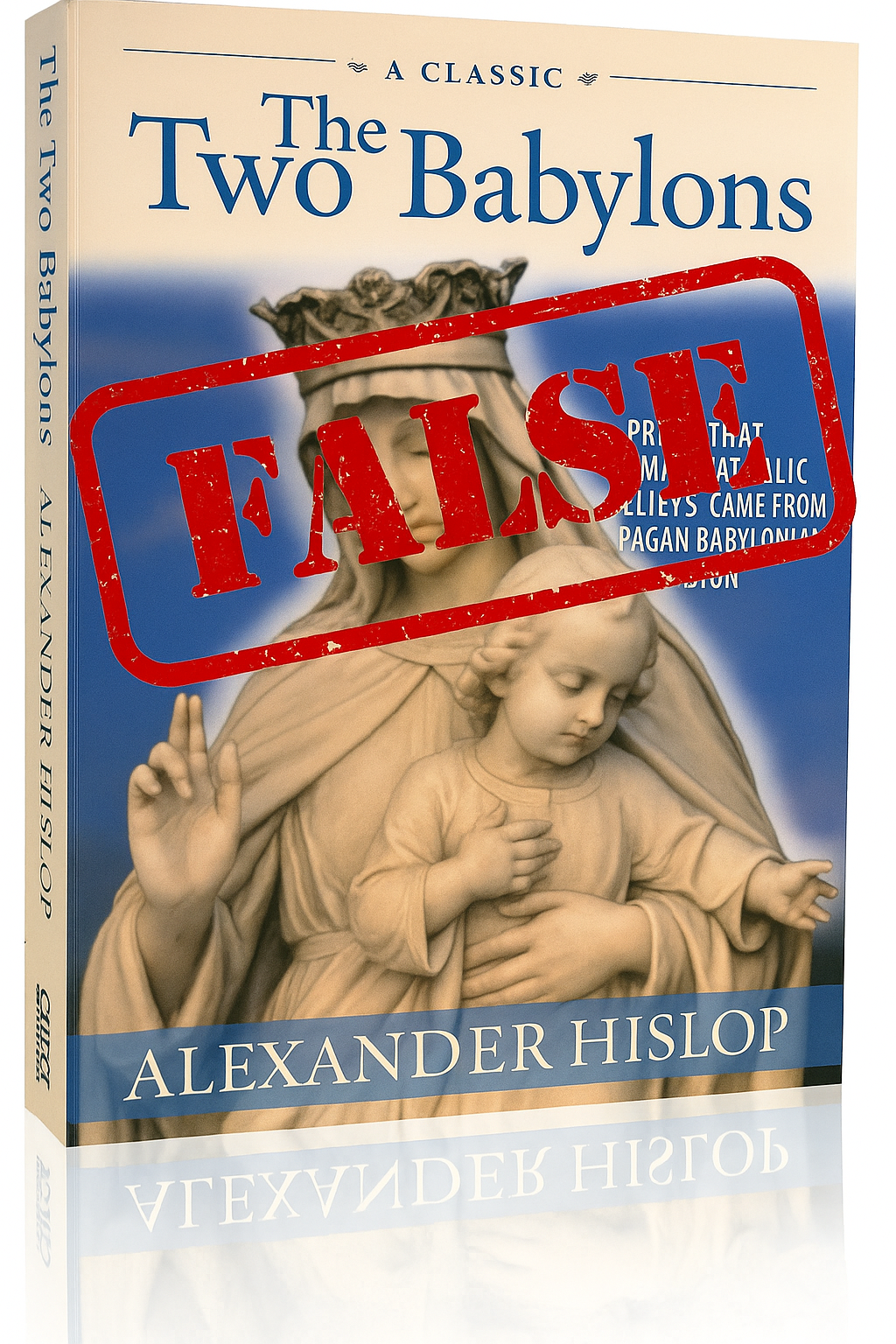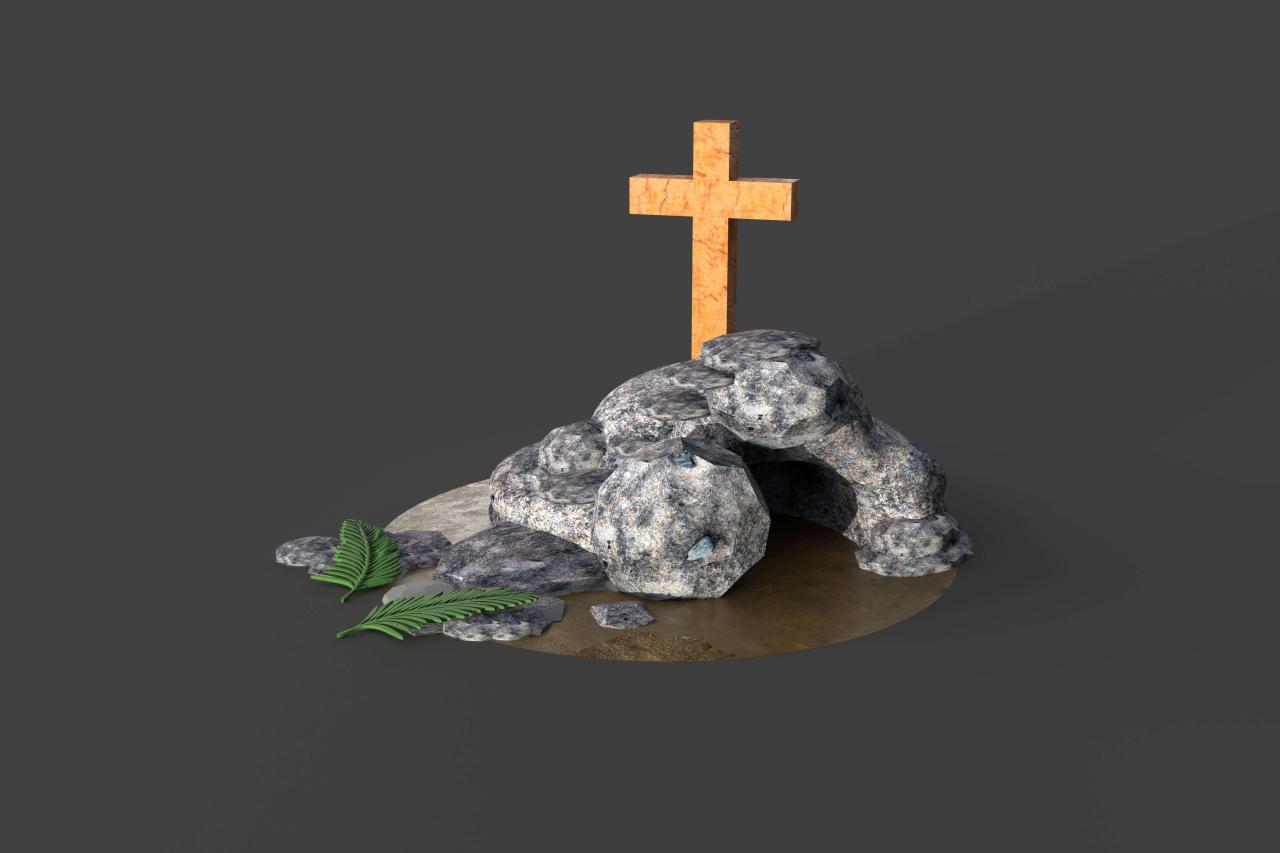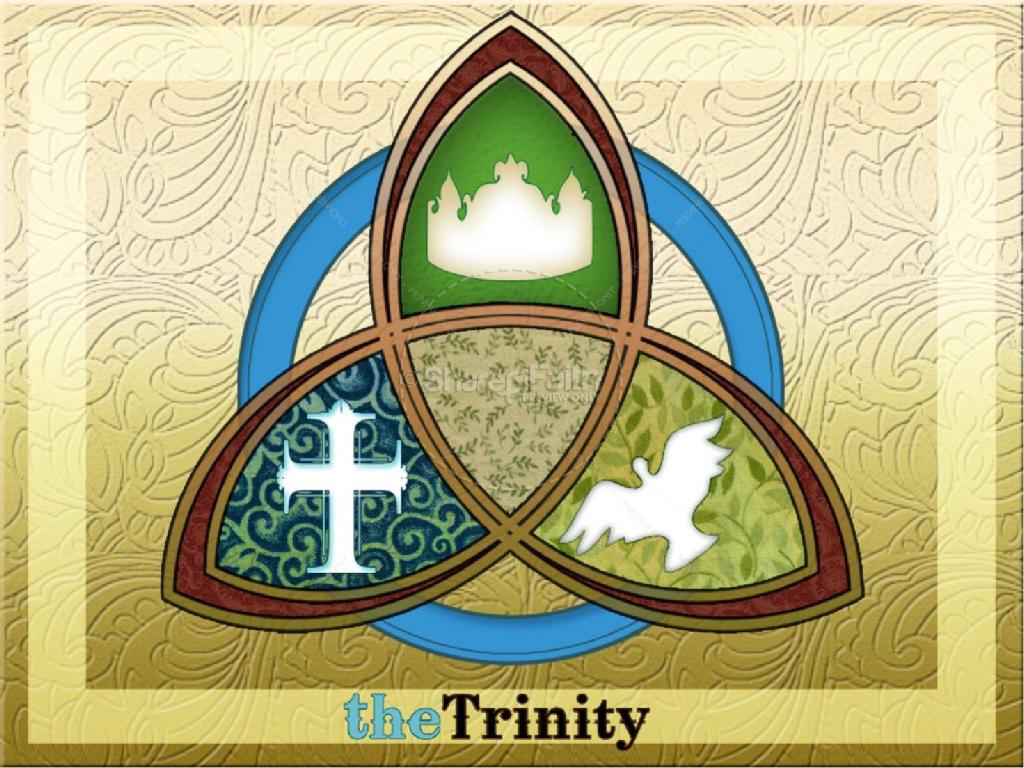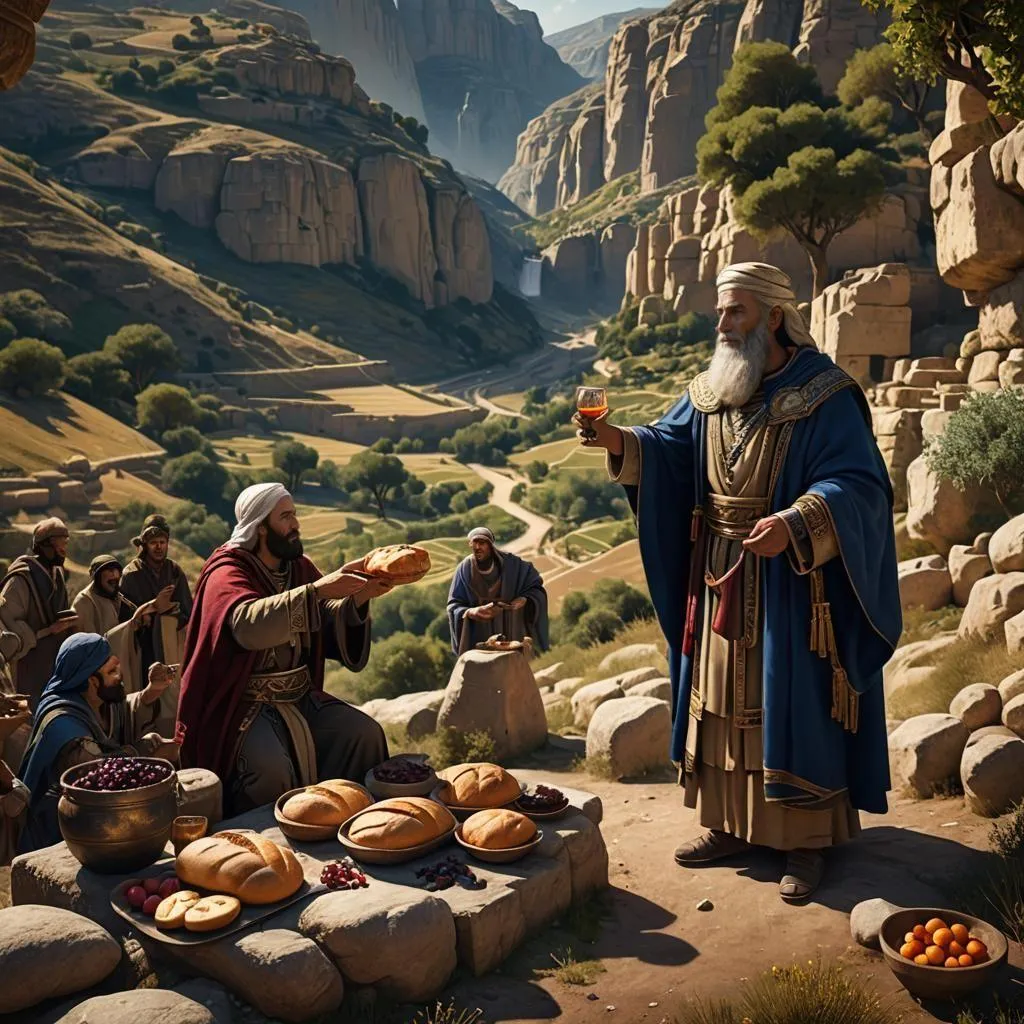Raised in the Heavenlies!
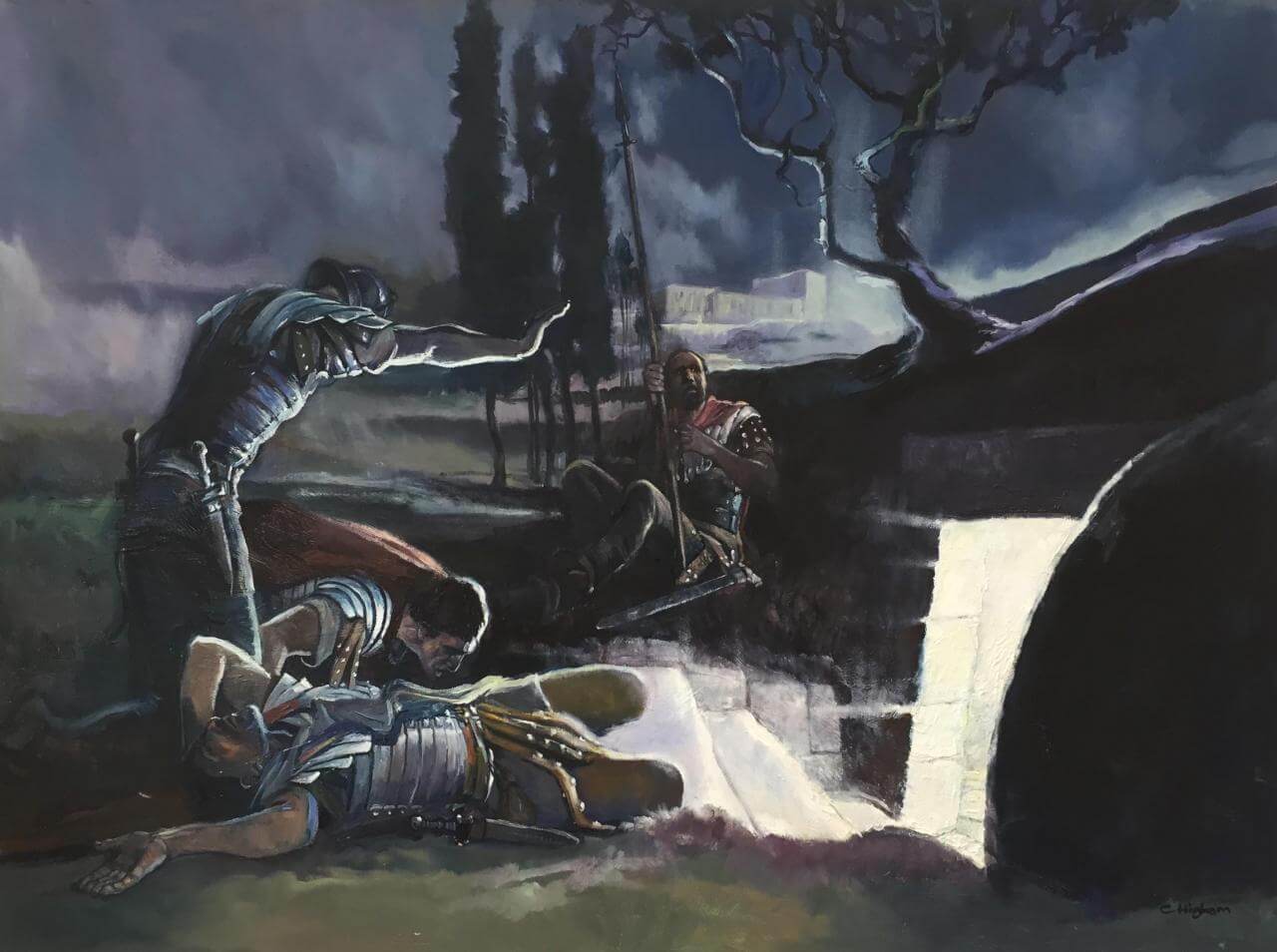
Easter is upon us once again! Lent is over, Good Friday has passed and now the time for mourning and fasting is complete. It's a time to feast, a time to remember and celebrate the resurrection of Christ as we look forward to our own final resurrection!
But what really is the resurrection? How will we be resurrected, and what does it mean for us that Jesus rose again? Let’s explore what this means for us as Christians, and see what the Scriptures say.
The resurrection is spiritual!
That heading may cause some reading this to question me, but do read on – this is actually what the New Testament teaches us (though not only this type of resurrection).
Many times in Scripture when speaking of baptism, it is used and described as a symbolic act of dying and being raised with Christ into a new creation, despite keeping our “old” bodies in the meantime. This, I believe, is why there was such an emphasis on the importance of baptism in the early Church, and why it’s something sacred we should also highly esteem and not take lightly.
As another blogger puts it, “baptism conveyed the gift of the Spirit and his illuminating and sanctifying roles … in being baptized, the new Christian experienced death (to self) and rebirth. Finally, baptism proclaimed the eschatological hope for restoration in the new creation.”
With that in mind, let's take a look at how baptism and resurrection relate to one another:
Colossians 2:12
When you were buried with him in baptism, you were also raised with him through faith in the power of God, who raised him from the dead.
Colossians 3:1
So if you have been raised with Christ, seek the things that are above, where Christ is, seated at the right hand of God.
Ephesians 2:5-6
…[God,] even when we were dead through our trespasses, made us alive together with Christ—by grace you have been saved— and raised us up with him and seated us with him in the heavenly places in Christ Jesus
Romans 6:4
Therefore we have been buried with him by baptism into death, so that, just as Christ was raised from the dead by the glory of the Father, so we too might walk in newness of life.
While these verses (and many others) make it clear that through baptism we die to our old selves and are raised anew in Christ, we must also understand that this prefigures our future resurrection when we finally “put on immortality”. Though we will eventually die physically in the body, we won't die at all because death is defeated and it has no sting nor power over us!
What happens in death?
You may have heard of the term “soul sleep”, which is the doctrine that when a person dies, their soul (or spirit) “sleeps” in the grave until the resurrection, knowing and experiencing nothing until that time. Some people accept this, especially certain other groups like Jehovah’s Witnesses and Seventh Day Adventists (based mainly on Eccl. 9:5), except that there are actually various Old Testament passages which speak of Sheol (the “grave”/underworld) as not necessarily being asleep, but as having some limited activity (Isa 14:9), despite it being described as a shadowy and sobre place, with no light nor joy (Job 10:20-22; Psalms 88:6).
New Testament theologian, N.T. Wright, describes this intermediate stage as being "conscious," but "compared to being bodily alive, it will be like being asleep". So sort of like a ‘dream state’ in that the level of awareness is limited; in God’s presence but not active in our own bodies and will.
By the time of Jesus, this doctrine or belief about the afterlife had developed, and Sheol (Hades in Greek) had become more defined in its description and how the dead were handled there. We can see an example of this in the parable of Jesus about the rich man and Lazarus (Luke 16:19-31) where the wicked are punished in a separate ‘section’ to where the righteous wait peacefully, kept apart by a huge gulf.
But this was said and taught pre-crucifixion and more importantly, pre-resurrection.
We get a small glimpse into the mystery of Jesus’ death and resurrection from Peter and Paul in their letters where Peter explains that Jesus “went and made a proclamation to the spirits in prison” (1 Peter 3:18-19) – “prison” being the place of the dead for those people from times of old who had died. Paul also, in his letter to the Ephesians, follows up on this same event when he says that Jesus, “who descended is the same one who ascended far above all the heavens, so that he might fill all things” and that in doing so “he made captivity itself a captive” (Eph 4: 8-10).
Death itself is captive to Jesus because he holds the keys to Death and Hades (Rev 1:18), and dare I say, this moment when the Light of the World went down into the shadowy darkness of Sheol, it was possibly the first and last time there was ever any light in that gloomy place!
Does this mean then, that Sheol/Hades is no longer inhabited? Is there no longer an “intermediate state”? These verses from Peter and Paul would suggest that it was emptied before, but doesn’t necessarily mean that Hades hasn’t been refilled since. Though if we take Hebrews into consideration, it would seem as though there is no need for a waiting place, since “is appointed for mortals to die once, and after that the judgment” (Heb 9:27), but it could be argued that there is still a period of time between the dying and the judgement. Even with Paul’s second letter to the Corinthians, when he says “we would rather be away from the body and at home with the Lord” (2 Cor 5:8), that still doesn’t necessarily say there’s no waiting in death before the final resurrection, but it does give hope that even in death, whatever it means, we will be present with our Lord in some form.
The resurrection is glorified!
I use the word “glorified” here because saying “physical” just isn't adequate enough to describe the mystery.
Our new bodies will be similar to our current physical bodies, but not the same – not limited like our earthly bodies are; in the same way Jesus was changed, we too shall also be transformed “into the likeness of His glorious body” (Phil 3:21)!
In the same way that spiritual beings such as angels can become “physical” in appearance, they aren't the same as we are now. Much like when Jesus ascended to the Father and later appeared to his disciples, he was no longer the same human Jesus they once knew (2 Cor 5:16).
Despite eating and drinking (Luke 24:39-43) and seeming the same as before, he now appeared in their midst behind locked doors (John 20:19); travelled with people in an unrecognisable form – or could control other’s perceptions of him until required (Luke 24:15-16), and the could also disappear in the blink of an eye (Luke 24:31)!
Christ was raised physically, initially, but then his body was different. Glorified, not human.
Origen captures this concept well in his book Contra Celsus;
“After his resurrection, Christ existed in an intermediate state, as it were. For it was somewhere between the physicalness of the body He had before his sufferings and the appearance of a soul uncovered by such a body. It was for this reason that … Jesus came and stood in [the disciples] midst, even though the doors were shut.”
– Origen, Contra Celsus, Book II, ch.62
Paul spends quite some time on the resurrection and explaining what it means and how it will be, though it is a topic that will always be limited by our human understanding, which is why the nature of the resurrection is always contrasted with the putting on of new clothes or in building a new tent, or the sowing of seeds. It is quite rightly a mystery, as Paul says!
This question of the “how” and “what” of the resurrection has been asked since the earliest times, one such example being by the Corinthian church (1 Cor 15:35). Both of Paul’s letters to the Corinthian church deal with the nature and doctrine of the resurrection quite frequently, using these various types of analogies of tent making and seed sowing, which would have been familiar imagery to first century people from rural backgrounds.
Even if you don’t have a farming background, it’s still easy to understand the concept of what is being said here in terms of our physical, mortal body being removed like an outer garment, and being replaced with something better:
2 Corinthians 5:1-2
For we know that if the earthly tent we live in is destroyed, we have a building from God, a house not made with hands, eternal in the heavens. For in this tent we groan, longing to be clothed with our heavenly dwelling
1 Corinthians 15:44
It is sown a physical body, it is raised a spiritual body. If there is a physical body, there is also a spiritual body.
This is the mystery which Paul expands on in 1 Cor 15:51-52 where he says that “we will all be changed, in a moment, in the blink of an eye” showing that the resurrection will be an instantaneous event – one minute mortal, the next immortal. This same type of language is used again by Paul when writing to the Thessalonian church and says that we “will be caught up in the clouds together with [the resurrected dead]” (1 Thes. 4:13-18) as not all of us will die and need to wait for the resurrection like those who have already died. These two passages of Scripture reflect one another and speak of the same event: resurrection.
Also note that this message in 1 Thess. was to encourage the believers about those who had already died because they were obviously worrying about what would become of their loved ones now. So Paul writes in order that they wouldn’t be “uninformed” about such things, and so that they wouldn’t grieve like “the rest” – ie. those who don't believe in Christ (1 Thess. 4:13). These words on being caught up and resurrected were specifically for the Church to “encourage one another with”. Any other doctrine that gets pulled out of it, is surely secondary to this.
Do we still need to wait for our resurrection, or has the waiting period passed and we can now be “absent from the body and present with the Lord” upon physical death? Some say “yes” to the waiting because they tie it in with the end of the world as we know it, and point to 2 Timothy 2:17-18 as proof that the resurrection hasn’t (or doesn’t) happen yet. Here Paul warns against some false teaching which stated that “the resurrection has already taken place” and in doing so they were “upsetting the faith” of those who listened.
But we must remember to keep things in context! Paul wrote this in a time when it was still true – the resurrection hadn't happened at that point, and he was still teaching it as a future event.
Scripture wasn't written in a vacuum; it is also confined by time too (as well as holding timeless truths), and it could be entirely possible that believers are glorified in death now. If we look at the curious verse in Matthew’s Gospel account, Matt 27:52-53 shows us that some type of resurrection did already happen, which possibly shows a fulfillment of John 5:28-29 when Jesus taught about those “who are in their graves will hear his voice and will come out” (cf. Dan 12:2).
Matthew writes that after Jesus rose again, “many bodies of the saints who had fallen asleep were raised … [and] they came out of the tombs and entered the holy city and appeared to many” – an odd account, which only appears here in Matthew 27, but in some way possibly displays what Paul later wrote about when he said Jesus was the “firstfruits” of resurrection, then the rest follow in the right order (1 Cor 15:23).
Ignatius, writing about this during the second century in his letter to the Trallians, explains this resurrection as being those to whom Jesus preached in Hades, and then raised up out of captivity along with himself, since he “descended, indeed, into Hades alone, but He arose accompanied by a multitude”!
Resurrection in Revelation
The “first” or “general” resurrection which is mentioned in the book of Revelation is often what people will point to and read when talking or thinking about our own future. But look where it takes place. Despite the symbolic nature of the text, it's still clear that this event isn't happening on earth, as the earth (and heaven) flee from God's presence! So where is this? Who knows, but it's definitely not somewhere physical or earthly.
Revelation 20:5, 11-12
The rest of the dead did not come to life until the 1,000 years were completed. This is the first resurrection … Then I saw a great white throne and One seated on it. Earth and heaven fled from His presence, and no place was found for them. I also saw the dead, the great and the small, standing before the throne, and books were opened.
This resurrection isn't on earth, or in our old bodies physically coming out of the graves! These are our new, spiritual and glorified bodies which have "grown" from the seed or mortality which were sown in death.
So what is the resurrection? It is a mystery of something which is deeply spiritual, yet also joined in the flesh of renewed bodies. It is hope for our future and peace over death, and encouragement for those who have had people they love die.
It is something we can rejoice in now through our baptism and new spiritual life in Christ by his Spirit within us, which makes us a new creation.
It is strange co-joining of this world and the heavenly realms where, despite still being in our tarnished flesh, we are also seated with Christ up high, waiting until the day in which we finally put on immortality and join our Lord in a restored creation.
It is, as Paul wrote, something that will happen in an instant – in a "twinkling of an eye"!
And, in the most important sense, it is Jesus. It’s only through him that we may find this life and take part in the resurrection.
John 11:25-26
I am the resurrection and the life. Those who believe in me, even though they die, will live, and everyone who lives and believes in me will never die.
Overall, the resurrection is the ultimate redemption of Creation. Our bodies will be renewed along with everything else. It's not about floating away to some heavenly, disembodied state of being but is all about our co-working with Christ for the reconciliation of all things back to God!
Even now in our current state, we are spiritually resurrected through baptism so that we can work alongside God in redeeming this world.
This is a very large and deep subject, but I hope this has given you something to want to study further and maybe even some encouragement about what God has planned for our bodies (and indeed, all of creation which is to be renewed – Romans 8:22-23), because salvation and redemption are based around this very concept. If anything, the fact that we, as Christians, look forward to a bodily resurrection says quite clearly that our future lies not in some distant, metaphysical realm, but in a very real and physical world, co-joined and redeemed with Heaven under God where He will be all in all (1 Cor 15:28).
If you are still confused about the resurrection, or worried about death in general, then I want to finish with this “modern parable” if you can call it that. I’m not sure where it is from or what its source is, I’ve just had it written down for some time now, but I like the example of the faith it describes, as that is what we should have in these matters, especially concerning death.
“A sick man turned to his doctor as he was preparing to leave the examination room and said, ‘Doctor, I am afraid to die. Tell me what lies on the other side.’
Very quietly, the doctor said, ‘I don’t know…’
‘You don’t know? You’re a Christian man and you don’t know what’s on the other side?’
The doctor was holding the handle of the door, on the other side came the sound of scratching and whining, and as he opened the door, a dog sprang into the room and leaped on him with an eager show of gladness.
Turning to the patient, the doctor said,
‘Did you notice my dog? He’s never been in this room before. He didn’t know what was inside. He knew nothing except that his master was here, and when the door opened, he sprang in without fear. I know little of what is on the other side of death, but I do know one thing… I know my Master is there and that is enough.’ ”
Further Reading
- http://www.newadvent.org/fathers/04162.htm
- https://carm.org/early-church-fathers-baptism
- http://www.patheos.com/blogs/anxiousbench/2013/10/5997/
- http://www.churchhistory101.com/feedback/water-baptism.php
- https://carm.org/soul-sleep
- http://www.gotquestions.org/soul-sleep.html
- http://www.crivoice.org/resurrection.html
- http://ntwrightpage.com/Wright_Jesus_Resurrection.htm
- http://ntwrightpage.com/
- N.T. Wright quote: Van Biema, David (2008-02-07). "Christians Wrong About Heaven, Says Bishop". Time. Retrieved 2010-05-22.
- http://www.biblicaltheology.ca/blue_files/(Re)New(ed)%20Creation-The%20End%20of%20the%20Story.pdf
- http://www.earlychristianwritings.com/text/ignatius-trallians-longer.html
Leave a comment Like Back to Top Seen 877 times Liked 0 times
Enjoying this content?
Support my work by becoming a patron on Patreon!
By joining, you help fund the time, research, and effort that goes into creating this content — and you’ll also get access to exclusive perks and updates.
Even a small amount per month makes a real difference. Thank you for your support!
Subscribe to Updates
If you enjoyed this, why not subscribe to free email updates and join over 853 subscribers today!
My new book is out now! Order today wherever you get books
Recent Posts
Luke J. Wilson | 8 days ago | Islam
You are not alone. Around the world, many Muslims — people who already believe in one God, pray, and seek to live righteously — are drawn to know more about Jesus (ʿĪsā in Arabic). Some have heard He is more than a prophet. Some have sensed His presence in a dream or vision. And some simply long to know God more deeply, personally, and truly. So what does it mean to become a Christian? And how can you take that step? This guide is for you. 1. What Christians Believe About God and Jesus ➤ One God, Eternal and Good Christians believe in one God — the same Creator known to Abraham, Moses, and the prophets. But we also believe God is more personal and relational than many realise. In His love, He has revealed Himself as Father, Son (Jesus), and Holy Spirit — not three gods, but one God in three persons. ➤ Jesus Is More Than a Prophet Muslims honour Jesus as a great prophet, born of the virgin Mary. Christians also affirm this — but go further. The Bible teaches that Jesus is the Word of God (Kalimat Allāh), who became flesh to live among us. He performed miracles, healed the sick, raised the dead — and lived without sin.Jesus came not just to teach but to save — to bring us back to God by bearing our sins and rising again in victory over death. 2. Why Do We Need Saving? ➤ The Problem: Sin All people — no matter their religion — struggle with sin. We lie, get angry, feel jealous, act selfishly, or fail to love God fully. The Bible says: “All have sinned and fall short of the glory of God.” (Romans 3:23) Sin separates us from God. And no matter how many good deeds we do, we can never make ourselves perfect or holy before Him. ➤ The Solution: Jesus Because God loves us, He did not leave us in our sin. He sent Jesus, His eternal Word, to live as one of us. Jesus died willingly, offering His life as a sacrifice for our sins, then rose again on the third day. “But God proves his love for us in that while we still were sinners Christ died for us.” (Romans 5:8) 3. How Do I Become a Christian? Becoming a Christian is not about joining a Western religion. It’s about entering a relationship with God through faith in Jesus Christ. Here is what the Bible says: ✝️ 1. Believe in Jesus Believe that Jesus is the Son of God, that He died for your sins, and that He rose again. “If you confess with your lips that Jesus is Lord and believe in your heart that God raised him from the dead, you will be saved.” (Romans 10:9) 💔 2. Repent of Your Sins Turn away from sin and ask God to forgive you. This is called repentance. It means being truly sorry and choosing a new way. “Repent therefore, and turn to God so that your sins may be wiped out.” (Acts 3:19) 💧 3. Be Baptised Jesus commands His followers to be baptised in water as a sign of their new life. Baptism represents washing away your old life and rising into a new one with Jesus. “Repent and be baptised every one of you in the name of Jesus Christ so that your sins may be forgiven.” (Acts 2:38) 🕊️ 4. Receive the Holy Spirit When you believe in Jesus, God gives you the Holy Spirit to live within you, guiding you, comforting you, and helping you follow His will. “You received the Spirit of adoption, by whom we cry, ‘Abba! Father!’” (Romans 8:15) 🧎 5. Begin a New Life As a Christian, you are born again — spiritually renewed. You begin to grow in faith, love, and holiness. You read the Bible, pray, fast, and gather with other believers. Your life is no longer your own; you now live for God. 4. What Does a Christian Life Look Like? Jesus said: “If anyone wants to become my followers, let them deny themselves and take up their cross and follow me.” (Matthew 16:24) This means: Loving God with all your heart Loving your neighbour — even your enemies Forgiving others ...
Luke J. Wilson | 05th May 2025 | Politics
When we think about David and Saul, we often focus on David’s rise to kingship or his battle with Goliath. But hidden within that story is a deep lesson for today’s generation about leadership, resistance, and the power of revolutionary love. At a recent youth training event (thanks to South West Youth Ministries), I was asked how I would present the story of David and Saul to a Christian teenage youth group. My mind turned to the politics of their relationship, and how David accepted Saul’s leadership, even when Saul had gone badly astray. David recognised that Saul was still God’s anointed king — placed there by God Himself — and that it was not David’s place to violently remove him. Gen-Z are more politically aware and engaged than previous generations, and are growing up in a world where politics, leadership, and social issues seem impossible to escape. We live in a world where political leaders — whether Trump, Putin, Starmer, or others — are often seen as examples of failed leadership. It’s easy to slip into bitterness, cynicism, or violent rhetoric. These kids are immersed in a culture of activism and outrage. As Christians, we’re called to care deeply about truth and justice and approach leadership differently from the world around us (Hosea 6:6; Isaiah 1:17; Micah 6:8). The story of David and Saul offers pertinent lessons for our modern lives. Respect Without Endorsement David’s respect for Saul was not blind loyalty. He did not agree with Saul’s actions, nor did he ignore Saul’s evil. David fled from Saul’s violence; he challenged Saul’s paranoia; he even cut the corner of Saul’s robe to prove he had the chance to kill him but chose not to. Yet throughout, David refused to take matters into his own hands by force. Why? Because David understood that even flawed authority ultimately rested in God’s hands, he trusted that God would remove Saul at the right time. This is echoed later in the New Testament when Paul writes in Romans 13 that “there is no authority except from God, and those authorities that exist have been instituted by God”, something even Jesus reminded Pilate of during his trial (John 19:10–11). In other words, even flawed leadership can be part of God’s bigger plan, whether for blessing or discipline. Even when leaders go bad, our call as believers is to maintain integrity, respect the position, and resist evil through righteousness — not rebellion. David and Saul: A Lesson in Respect and Restraint Saul was Israel’s first king — anointed by God but later corrupted by pride, fear, and violence. David, chosen to succeed him, spent years running for his life from Saul’s jealous rage. One day, David found Saul alone and vulnerable in a cave. His men urged him to strike Saul down and end the conflict. But David refused: “I will not raise my hand against my lord; for he is the Lord’s anointed.” (1 Samuel 24:10) Instead of killing Saul, David cut off a piece of his robe to prove he could have harmed him, but didn’t. In doing so, he demonstrated a real form of nonviolent resistance. He stood firm against Saul’s injustice without resorting to injustice himself, and acted in a way that could try to humble Saul instead. Peacemaking Is Not Passivity There is a modern misconception that peacemaking means doing nothing and just letting injustice roll all over us. But true biblical peacemaking is not passive; it actively resists evil without becoming evil. Interestingly, David’s actions toward Saul also foreshadow the type of nonviolent resistance Jesus later taught. When Jesus commanded His followers to turn the other cheek, go the extra mile, and love their enemies, he was not calling for passive submission but offering what scholar Walter Wink describes as a “third way” — a bold, peaceful form of resistance that uses what he calls “moral jiu-jitsu” to expose injustice without resorting to violenc...
Luke J. Wilson | 21st April 2025 | Easter
Over the years, I’ve encountered many Christians who’ve quoted from Alexander Hislop’s The Two Babylons as if it were a solid historical resource. The book claims that the Roman Catholic Church is not truly Christian but rather a continuation of ancient Babylonian religion. It’s self-assured and sweeping, and for many people, it seems to explain everything, from Marian devotion to Lent and Easter, to Christmas, as rooted in paganism. But is it accurate? In short: no, it really isn’t. Hislop’s work is a classic example of 19th-century pseudohistory — a polemical piece, written to prove a point, not to explore any historical truth. Flawed Methods and Wild Claims Hislop argues that most Catholic practices — from the Mass and clerical robes to festivals like Christmas and Easter — were somehow borrowed from Babylonian religion. The problem being that Hislop doesn’t rely on primary sources or credible historical data. Instead, he draws connections based on word similarities (like Easter and Ishtar) or visual resemblances (like Mary and child compared with mother-goddess statues from ancient cultures). But phonetic resemblance isn’t evidence, and neither is visual similarity. For example, if I say “sun” and “son” in English, they may sound alike, but they aren’t the same thing. That’s the level of reasoning at work in much of The Two Babylons. Hislop often lumps together completely different ancient figures — Isis, Semiramis, Ishtar, Aphrodite — as if they were all just variations of the same deity. He then tries to say Mary is just the Christian version of this pagan goddess figure. But there’s no credible evidence for that at all. Mary is understood through the lens of Scripture and Christian theology, not through pagan myth. The earliest depictions of Mary and the Christ-child date back to the second century and do not resemble any of the pagan idols. But, again, the common accusations are based on superficial similarities of a woman nursing a child. That’s going to look the same no matter who or what does that! Oldest depiction of Mary. Dura-Europos Church, Syria, 2nd century What About Lent and Tammuz? One of Hislop’s more popular claims is that Lent comes from a Babylonian mourning ritual for the god Tammuz, mentioned in Ezekiel 8:14. He argues that early Christians borrowed the 40-day mourning period and just rebranded it. But this doesn’t line up with the evidence. Lent developed as a time of fasting and repentance leading up to Easter — especially for new believers preparing for baptism. The number forty comes from Scripture: Jesus’ forty days in the wilderness, Moses’ fast on Sinai, and Elijah’s journey to Horeb. Church Fathers like Irenaeus and Athanasius saw it as a time for self-denial and spiritual renewal — not mourning a pagan god. Yes, there are pagan festivals that involve seasonal death and rebirth stories. But similarity does not mean origin. If that logic held, then even Jesus’ resurrection would be suspect because pagan cultures also told resurrection-like stories. Yet the gospel stands apart — not because of myth but because of history and revelation. Why Hislop’s Work Persists Even though The Two Babylons is poor scholarship, it’s unfortunately had a long shelf life. That’s partly because it appeals to a certain kind of suspicion. If you’re already sceptical about the Catholic Church, Hislop offers an easy explanation: “It’s all pagan!”. But history isn’t ever that simple. And theology — especially the theology handed down through the ages by the faithful— isn’t built on conspiracy and apparent obscure connections, but on Christ and the truth of the Scriptures. Interestingly, even Ralph Woodrow, a minister who once wrote a book defending Hislop’s ideas, later retracted his views after digging deeper into the evidence. He eventually wrote a book called The Babylon Connect...
Darwin to Jesus | 16th April 2025 | Atheism
Guest post by Darwin to Jesus Dostoevsky famously said, “If there is no God, then everything is permitted.” For years, as an atheist, I couldn’t understand what he meant, but now I do… Here’s a simple analogy that shows why only theism can make sense of morality: Imagine you just got hired at a company. You show up, set up your desk, and decide to use two large monitors. No big deal, right? But then some random guy walks up to you and says: “Hey, you’re not allowed to do that.” You ask, “What do you mean?” They say, “You’re not permitted* to use monitors that big.” In this situation, the correct response would be: “Says who?” We’ll now explore the different kinds of answers you might hear — each one representing a popular moral theory without God — and why none of them actually work. Subjective Morality The random guy says, “Well, I personally just happen to not like big monitors. I find them annoying.” Notice that’s not a reason for you to change your setup. Their personal preferences don’t impose obligations on you. This is what subjective morality looks like. It reduces morality to private taste. If this were the answer, you’d be correct to ignore this person and get back to work — big monitors are still permitted. Cultural Relativism Instead, they say, “It’s not just me — most people here don’t use big monitors. It’s not our culture.” That’s cultural relativism: right and wrong are just social customs, what is normal behavior. But notice customs aren’t obligations. If the culture were different, the moral rule would be different, which means it isn’t really moral at all. You might not fit in. You might not be liked. But you’re still permitted to use big monitors. Emotivism Here after being asked “says who?” the person just blurts out, “Boo, big monitors!” You reply, “Hurrah, big monitors!” That’s the entire conversation. This is emotivism. On this moral theory when we talk about right and wrong we’re actually just expressing our personal feelings towards actions, I boo rape, you hurrah rape. But shouting “boo!” at someone doesn’t create real obligations. You’re still permitted to use large monitors. Utilitarianism Here, the person says, “Your big monitors lower the overall productivity of the office. You’re not permitted to use them because they lead to worse consequences.” This is utilitarianism: morality is based on producing the greatest happiness for the greatest number. But even if that’s true — so what? Who says you’re obligated to maximize group productivity? And what if your monitors actually help you work better? Utilitarianism might tell you what leads to better outcomes, but it doesn’t tell you why you’re morally obligated to follow that path — especially if it comes at your own expense. You’re still permitted to use large monitors. Virtue Ethics Here they say, “Using big monitors just doesn’t reflect the virtues we admire here — simplicity, humility, restraint.” This is virtue ethics. Morality is about becoming the right kind of person. But who defines those virtues? And why are you obligated to follow them? What if your idea of a virtuous worker includes productivity and confidence? Without a transcendent standard, virtues are just cultural preferences dressed up in moral language. If you don’t care about virtue or their arbitrary standards, then you have no obligation. You’re still permitted to use large monitors. Atheist Moral Realism But what if they say, “Listen, there’s a rule. It’s always been here. It says you can’t use monitors that large.” You ask, “Who made the rule?” They say, “No one.” You ask, “Who owns this company?” They say, “No one owns it. The company just exists.” You look around and ask, “Where is the rule?” They say, “You won’t find it w...


